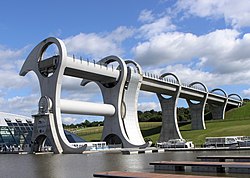| Name | Location | Opened | Type | Displacement | Dimensions | Vertical lift | Cycle time | Notes |
|---|
| Goupitan ship-lifting system (second [6] lift) | Guizhou, China | 2021 [7] | Vertical caisson | 500 tons | 280 by 35 by 5 metres
919 by 115 by 16 feet | 127 metres
417 feet | | Tallest boat lift in the world. |
| Goupitan ship-lifting system (first [6] lift) | Guizhou, China | 2021 [7] | Vertical caisson | 500 tons | | 72–79 metres
236–259 feet | | |
| Three Gorges Dam ship lift | Yichang, Hubei, China | 2016 | Vertical caisson | 3000 tons | 280 by 35 by 5 metres
919 by 115 by 16 feet | 113 metres
371 feet | 30–40 minutes | |
| Krasnoyarsk Dam ship lift | Divnogorsk, Krasnoyarsk Krai, Russia | 1982 | Inclined plane | 1500 tons | 90 m × 18 m × 2.2 m
295 ft × 59 ft × 7 ft | 104 m
341 ft | 90 minutes | |
| Ronquières inclined plane lift | Braine-le-Comte, Hainaut, Belgium | 1968 | Inclined plane | 1350 tons | 91 m × 12 m × 3.7 m
299 ft × 39 ft × 12 ft | 67.73 m
222 ft | 22 minutes [8] | |
| Strépy-Thieu boat lift | Le Rœulx, Hainaut, Belgium | 2002 | Vertical caisson | 1350 tons | 112 m × 12 m × 3.35 m
367 ft × 39 ft × 11 ft | 73.15 m
240 ft | 7 minutes | Tallest boat lift in Europe. |
| Scharnebeck twin ship lift | Lüneburg, Lower Saxony, Germany | 1974 | Vertical caisson | 1350 tons | 105.4 m × 15.8 m × 3.4 m
346 ft × 52 ft × 11 ft | 38 m
125 ft | 3 minutes | |
| Niederfinow boat lift | Brandenburg, Germany | 1934 | Vertical caisson | | 85 m × 12 m × 2.5 m
279 ft × 39 ft × 8 ft | 36 m
118 ft | 20 minutes | |
| Niederfinow north boat lift | Brandenburg, Germany | 2022 | Vertical caisson | 2100 tonnes | 115 m × 12.5 m × 4.0 m
377 ft × 41 ft × 13 ft | 36 m
118 ft | | |
| Peterborough lift lock | Ontario, Canada | 1904 | Vertical caisson | 1300 tons | 42.7 m × 10.1 m × 2.1 m
140 ft × 33 ft × 7 ft | 19.8 m
65 ft | 10 minutes | |
| Kirkfield Lift Lock | Ontario, Canada | 1907 | Vertical caisson | 1300 tons | 42.7 m × 10.1 m × 2.1 m
140 ft × 33 ft × 7 ft | 14.9 m
49 ft | 10 minutes | |
| Rothensee boat lift | Saxony-Anhalt, Germany | 1938 | Vertical caisson | 1000 tons | 85 m × 12.2 m
279 ft × 40 ft | 16 m
52 ft | 20 minutes | |
| Falkirk Wheel | Falkirk, Scotland, United Kingdom | 2002 | Rotating caisson | 600 tons | 21.33 m × 6 m × 1.37 m
70 ft × 20 ft × 4 ft | 24 m
79 fts | 4 minutes | The only rotating boat lift in the world. |
| Henrichenburg boat lift | North Rhine-Westphalia, Germany | 1962 | Vertical caisson | 600 tons | 67 m × 8.2 m × 2 m
220 ft × 27 ft × 7 ft | 14 m
46 ft | 25 minutes | |
| Geheyan Dam ship lift | Hubei, China | 1987 | Vertical caisson | 300 tons | | | | |
| Longtan Dam ship lift (first lift) | Hechi, Guangxi Autonomous Region, China | 2020 | Vertical caisson | 500 tons | 73.0 m × 12.2 m × 3.5 m
240 ft × 40 ft × 11 ft | 62.4 m
205 ft [9] | | |
| Longtan Dam ship lift (second lift) | Hechi, Guangxi Autonomous Region, China | 2020 | Vertical caisson | 500 tons | 73.0 m × 12.2 m × 3.5 m
240 ft × 40 ft × 11 ft | 93.6 m
307 ft [9] | | |
| Canal du Centre boat lifts | Hainaut, Belgium | 1888–1917 | Vertical caisson | 360 tons/350 tons | 40.1 m × 5.06 m × 2 m
132 ft × 17 ft × 7 ft | 16.93–15.4 m
56–51 ft | | Three lifts each 16.93 m high plus one 15.4 m high. |
| Fontinettes boat lift | Arques, Pas-de-Calais, France | 1881–88 | Vertical caisson | 300 tons | 39 m × 5.2 m × 2 m
128 ft × 17 ft × 7 ft | 13.13 m
43 ft | 5 minutes | Replaced by a single lock in 1967. |
| Anderton boat lift | Cheshire, England, United Kingdom | 1875 | Vertical caisson | 250 tons | 22.9 m × 4.7 m × 2.9 m
75 ft × 15 ft × 10 ft | 15.25 m
50 ft | | |
| Montech water slope | Montech, Tarn-et-Garonne, France | 1974 | Water slope | | 443 m × 13.3 m × 6 m
1,453 ft × 44 ft × 20 ft | 13.3 m
44 ft | 6 minutes | Oldest water slope. |
| Fonserannes Water Slope | Hérault, France | 1980–83 | Water slope | | 272 m × 13.6 m
892 ft × 45 ft | 13.6 m
45 ft | | |
| Big Chute Marine Railway | Ontario, Canada | 1917–78 | Patent slip | | 30.4 m × 18 m × 7.9 m
100 ft × 59 ft × 26 ft | 18 m
59 ft | | |


